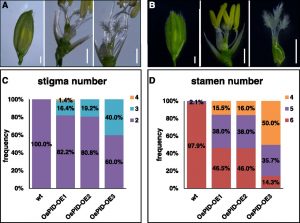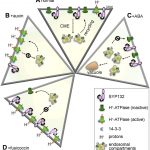PINOID Is Required for Formation of the Stigma and Style in Rice
In rice (Oryza sativa), both the male and female floral organs are produced in the same flower: thus, only rarely do rice grains result from cross-pollination. Since cross-pollination is difficult in rice so, too, is the production of hybrid seed. Plants with defective stigmas may have commercial value in the production of such hybrids. Despite the obvious importance of stigmas in plant sexual reproduction, very little is known about the molecular mechanisms by which stigmatic tissues are initiated in their  characteristic patterns. In Arabidopsis and maize (Zea mays), disruption of the protein kinase PINOID (PID) causes severe developmental defects in flower initiation. The Arabidopsis pid mutants, for example, develop striking pin-like inflorescences (thus the name PINOID). He et al. (10.1104/pp.18.01389) report that disruption of the rice PINOID (OsPID) gene completely eliminates the development of stigmas, and overexpression of OsPID leads to an overproliferation of stigmas, suggesting that OsPID is a key determinant for stigma development. Interestingly, ospid mutants did not display defects in flower initiation, nor did they develop any pin-like inflorescences as in other species so far studied. The authors knocked out one of the NAKED PINS IN YUC MUTANTS (NPY) genes, which cause the formation of pin-like inflorescences in Arabidopsis when compromised, in the ospid background. The ospid osnpy2 double mutants developed pin-like inflorescences, which were phenotypically similar to pid mutants in Arabidopsis and maize, demonstrating that the roles of OsPID in inflorescence development are likely masked by redundant partners.
characteristic patterns. In Arabidopsis and maize (Zea mays), disruption of the protein kinase PINOID (PID) causes severe developmental defects in flower initiation. The Arabidopsis pid mutants, for example, develop striking pin-like inflorescences (thus the name PINOID). He et al. (10.1104/pp.18.01389) report that disruption of the rice PINOID (OsPID) gene completely eliminates the development of stigmas, and overexpression of OsPID leads to an overproliferation of stigmas, suggesting that OsPID is a key determinant for stigma development. Interestingly, ospid mutants did not display defects in flower initiation, nor did they develop any pin-like inflorescences as in other species so far studied. The authors knocked out one of the NAKED PINS IN YUC MUTANTS (NPY) genes, which cause the formation of pin-like inflorescences in Arabidopsis when compromised, in the ospid background. The ospid osnpy2 double mutants developed pin-like inflorescences, which were phenotypically similar to pid mutants in Arabidopsis and maize, demonstrating that the roles of OsPID in inflorescence development are likely masked by redundant partners.



